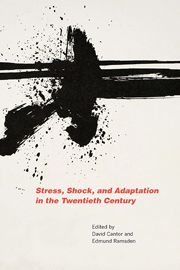Book contents
- Frontmatter
- Contents
- Acknowledgments
- Introduction
- Part One Packaging Stress
- Part Two Trauma and Acute Stress
- Part Three War
- Part Four Work
- Part Five Managing Stress
- Part Six Surveilling Stress
- 11 Stress in the City: Mental Health, Urban Planning, and the Social Sciences in the Postwar United States
- 12 Sadness in Camberwell: Imagining Stress and Constructing History in Postwar Britain
- List of Contributors
- Index
12 - Sadness in Camberwell: Imagining Stress and Constructing History in Postwar Britain
from Part Six - Surveilling Stress
Published online by Cambridge University Press: 05 April 2014
- Frontmatter
- Contents
- Acknowledgments
- Introduction
- Part One Packaging Stress
- Part Two Trauma and Acute Stress
- Part Three War
- Part Four Work
- Part Five Managing Stress
- Part Six Surveilling Stress
- 11 Stress in the City: Mental Health, Urban Planning, and the Social Sciences in the Postwar United States
- 12 Sadness in Camberwell: Imagining Stress and Constructing History in Postwar Britain
- List of Contributors
- Index
Summary
Introduction: Stress and the Problem of Temporality
Implicit within every model of stress is a particular understanding of time. Stress disorders, in their myriad forms, are variously attributed to the fears and terrors of an anticipated future, the pressure of present circumstances, or traumas arising from events buried deep in the individual's past. They are also associated with temporal experience being connected to the increased velocity of life or its slowing down through long episodes of boredom or sensory deprivation. Psychosomatic medicine, in its various forms and iterations over the past two hundred years, has sustained these different temporalities through reference to a rich armamentarium of psychological and physiological objects—ranging from the practices of “expectant attention” described by nineteenth-century mental physiologists through to the hypothalamicpituitary-adrenal (HPA) axis that plays a central role in twenty-first-century understandings of the stress response.
The sheer number of concepts deployed in descriptions of the stress response and the broad variety of narratives that these make possible have attracted widespread critical comment from anthropologists, historians, cultural critics, and practicing stress researchers. Stress is derided as a sort of “conceptual glue” that can connect forms of physiological and psychological disturbance to any number of experiences and events. While these criticisms are rich and often provocative it is not my intention to rehearse them again here. Rather, I want to concentrate on how stress disorders have been connected to specific life events and ways in which those connections have been stabilized.
- Type
- Chapter
- Information
- Stress, Shock, and Adaptation in the Twentieth Century , pp. 320 - 342Publisher: Boydell & BrewerPrint publication year: 2014

